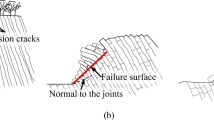Abstract
In highway projects, the common destruction effects of earthquake faults include the sand seismic liquefaction, the instability and failure of slopes. Thereinto, the dynamic instability of slopes induced by earthquake faults is most commonly seen. In order to research the influences of the destruction effects of earthquake faults on the dynamic stability of highway slopes, the distribution of previous earthquakes happening in the research area is qualitatively analyzed to establish the earthquake fault model and explore the kinematic characteristics. On this basis, representative slopes–cutting slopes in seismic damage areas are selected to calculate their earthquake response using the ABAQUS finite element program. The displacement field and acceleration output from the program are used to analyze the variation in the displacement of slope top and calculate the distribution coefficient of acceleration. Then, the stress fields output by the dynamic finite element analysis (FEA) are substituted in the genetic algorithm programmed by MATLAB to obtain the time history curves of safety factor of slopes and intelligently search the critical slip surfaces. By doing so, the changing rule of safety factor with seismic acceleration is obtained, together with the range of the safety factor of the envelope diagram of critical slip surfaces.














Similar content being viewed by others
References
Aki K (1979) Characterization of barriers on an earthquake fault. J Geophys Res: Solid Earth 84(B11):6140–6148
Bamber JL (1994) Ice sheet altimeter processing scheme. Int J Remote Sens 15(4):925–938
Bray JD, Seed RB, Cluff LS et al (1994) Earthquake fault rupture propagation through soil. J Geotech Eng 120(3):543–561
Chen ZY (2005) The soil slope stability analysis[M]. China WaterPower Press, Beijing
Choi SJ, Jeon JS, Choi JH et al (2014) Estimation of possible maximum earthquake magnitudes of Quaternary faults in the southern Korean Peninsula. Quatern Int 344:53–63
Choi JH, Kim YS, Choi SJ (2015) Identification of a suspected Quaternary fault in eastern Korea: proposal for a paleoseismic research procedure for the mapping of active faults in Korea. J Asian Earth Sci 113:897–908
Conforti M, Pascale S, Robustelli G et al (2014) Evaluation of prediction capability of the artificial neural networks for mapping landslide susceptibility in the Turbolo River catchment (northern Calabria, Italy). Catena 113:236–250
Galli PAC, Peronace E, Quadrio B et al (2014) Earthquake fingerprints along fault scarps: a case study of the Irpinia 1980 earthquake fault (southern Apennines). Geomorphology 206:97–106
Gao W (2016) Premium-penalty ant colony optimization and its application in slope stability analysis. Appl Soft Comput 43:480–488
Goldberg DE, Holland JH (1988) Genetic algorithms and machine learning[J]. Mach Learn 3(2):95–99
Heki K, Miyazaki S, Tsuji H (1997) Silent fault slip following an interplate thrust earthquake at the Japan Trench. Nature 386:595–598
Housing and urban-rural development of the People’s Republic of China (2010) The state administration of quality supervision, inspection and quarantine of the People’s Republic of China. Earthquake Resistant Design Code (GB50011-2010) [S]. China Architecture and Building Press, Beijing
Kang YJ (2009) Calculation method and application research for the Time-History of factor of safety of slopes subjected to seismic load[D]. Tsinghua University, Beijing
Kashani AR, Gandomi AH, Mousavi M (2016) Imperialistic competitive algorithm: a metaheuristic algorithm for locating the critical slip surface in 2-dimensional soil slopes. Geosci Front 7(1):83–89
Li H, Wang H, Xu Z et al (2013) Characteristics of the fault-related rocks, fault zones and the principal slip zone in the Wenchuan Earthquake Fault Scientific Drilling Project Hole-1 (WFSD-1). Tectonophysics 584:23–42
Molnar P, Qidong D (1984) Faulting associated with large earthquakes and the average rate of deformation in central and eastern Asia. J Geophys Res Solid Earth 89(B7):6203–6227
Nguyen VU (1985) Determination of critical slip surface. J Geotech Eng ASCE 111:238–251
Yan ZH (1983) Homogeneous earth dam and non homogeneous earth dam stability safety coefficient of extreme value distribution and the introduction of computer program. Water conserv Hydropower Tech 7:9–15
Acknowledgments
This work was supported by the [China National Natural Science Foundation] under Grant [number 41402259]; [Natural Science Foundation Key Projects of Hubei Province] under Grant [number 2013CFA110].
Author information
Authors and Affiliations
Corresponding author
Rights and permissions
About this article
Cite this article
Li, B., Wu, L., Chen, J. et al. The Influences of Destruction Effects of Earthquake Faults on the Dynamic Stability of Highway Slopes. Geotech Geol Eng 34, 1513–1523 (2016). https://doi.org/10.1007/s10706-016-0058-y
Received:
Accepted:
Published:
Issue Date:
DOI: https://doi.org/10.1007/s10706-016-0058-y




